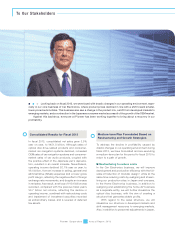Pioneer 2013 Annual Report Download - page 16
Download and view the complete annual report
Please find page 16 of the 2013 Pioneer annual report below. You can navigate through the pages in the report by either clicking on the pages listed below, or by using the keyword search tool below to find specific information within the annual report.
In addition to research and development in basic technologies to strengthen and expand our
existing businesses, Pioneer is actively engaged in research and development for future growth in our new
businesses of medical and healthcare devices, and organic light-emitting diode (OLED) lighting.
With regard to the new business area of medical devices in particular, in addition to the development of a
high-sensitivity imaging HEED-HARP device for endoscope cameras, we are working toward the development
of a camera that can take pictures using low-dose X-rays. We are utilizing the strong radiation-tolerance of
these devices to develop businesses in areas other than medicine.
Also, we continue to develop basic technologies in our traditional strengths of video, optics, and audio,
and to pursue applied research using these technologies. One example of this is our research in terahertz
imaging, a technology that holds promise for various areas including nondestructive inspection, security,
and medicine.
Pioneer also proactively pursues joint research with universities, public research institutions, and other
companies to achieve innovative breakthroughs and accelerate research and development.
Research and Development
▲
HEED-HARP image sensor
High-sensitivity, Radiation-tolerant Camera
HEED-HARP devices are imaging devices for small,
high-sensitivity cameras that combine a HEED*1,
developed by Pioneer, with a HARP*2, developed by
NHK Science & Technology Research Laboratories
and others. HEED-HARP devices have high radiation
tolerance, and since 2012 we have been working with
Tokyo City University in a national project for develop-
ment of systems and technologies for an advanced
measurement and analysis program in the field of
radiation measurement to develop a high-sensitivity,
radiation-tolerant camera employing this device.
High-sensitivity, radiation-tolerant HEED-HARP
devices make it possible to take clear, vivid images
with very little light in locations with high radioactivity,
where conventional CCD image sensors cannot be
used, and therefore hold promise for use in situations
like accidents at nuclear power plants. We are further
enhancing the radiation tolerance of our HEED-HARP
devices to create surveillance cameras that can oper-
ate stably for long periods of time inside nuclear power
plants and nearby areas with high levels of radiation.
*1 High-efficiency Electron Emission Device: A device capable of uniform
electron emission from each pixel, with superior electron emission
efficiency using low operating voltage
*2
High-gain Avalanche Rushing amorphous Photoconductor: High-
sensitivity film that converts and multiplies light into electric charges
that become an electric signal
▲
Diagram of HEED-HARP concept
Electron beam
HEED cold cathode HEED cold cathode array
Active-matrix drive circuit
Pixel
Light
HARP film
Electric
charge
Carbon layer
Upper metal electrode
Lower metal electrode
Silicon oxide
(SiOx) layer
Silicon layer
Light
Pioneer Corporation Annual Report 2013
14
























